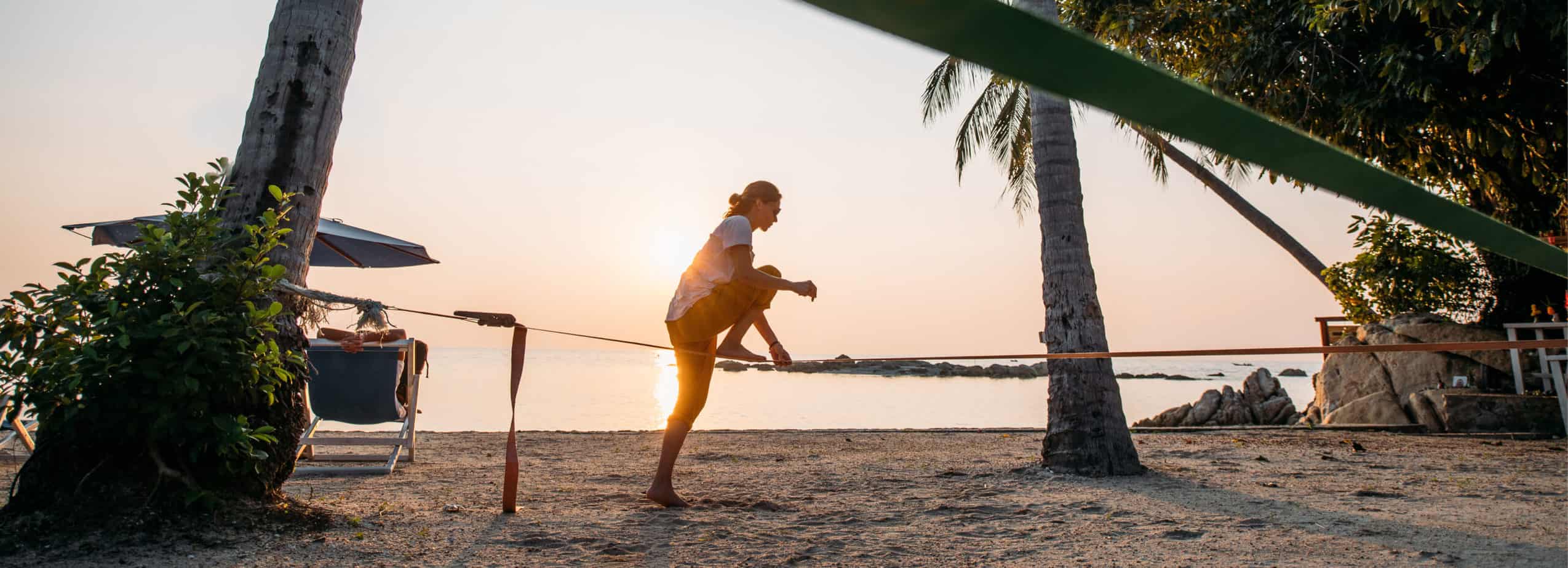Since it takes some time and effort to set up your slackline with the tension and slackness you require, you might wonder if it’s okay to leave it up in place attached to the trees even when it’s not in use.
You should not leave a slackline up overnight as the webbing and metal parts can be weather damaged over time. You also leave yourself open to someone using the slackline without permission which could cause an injury and thus liability to you. The slackline could also be stolen or vandalized.
Here are the 5 main reasons you shouldn’t leave a slackline up overnight in detail.
Slackline damage
Depending on where you live and the weather conditions you face, your slackline webbing can be exposed to (and thus damaged over time) by water, direct sun, UV, dirt, chemicals, dust and other hazards.
The ratchets and tethering components usually have metal parts which can experience weathering from the same sources listed above which can not only affect their look but in some cases their strength.
You may also experience the possibility that someone damages your slackline or ratchet system through misuse.
The longer you keep the slackline exposed to outdoor weather conditions, the more likely your nylon or polyester slackline will deteriorate perhaps quicker than you would like or expect.
Taking your slackline down after use is the smart thing to do even with the extra work involved in setting it up and removing it each time, as we’ll see below.
Slackline manufacturers like GIBBON Slacklines don’t recommend leaving them up overnight either.
Fixpoint damage
You typically attach your slackline to two trees so leaving it in place snugly fastened to trees overnight or longer can damage the trees. This is especially true if you don’t use tree protection which you should.
Highly tensioned slacklines can damage the bark of the tree especially if the trees are still growing. Check out these pictures of a slackline that had been set up and left on an 11-year old tree for 3 years and see the damage caused.
It should also be noted that some tree species are more robust than others. Some tree species are more likely to suffer bark and trunk damage than others which can lead to infestation, disease and in extreme cases, death of the tree.
Over time, leaving a slackline up could prematurely wear your slackline tethering and any metal parts which can make them a safety hazard.
Check out my article called Does Slacklining Damage Trees to learn more.
Injury potential
If you leave a slackline up in place when not in use and unattended, you run the risk of someone using it and injuring themselves.
Granted, if the slackline is set up in your own fenced off backyard and you have no kids, there is perhaps little chance of injury by someone gaining access to your backyard and using your slackline without permission.
Still, adults also do things they shouldn’t and you don’t want to run the risk that someone accesses your slackline while you’re not there to put a stop to it.
Which leads us to our last point regarding the potential of not only an injury but personal liability too.
Liability concerns
If you set up your slackline in a public area such as a park, camping site or beach or anywhere it can easily be accessed by others when you’re not around, you definitely want to remove it when you are finished.
Not only do you run the risk of someone using the slackline and hurting themselves, you also leave yourself open to being held liable should an injury occur.
Unless you have two large trees in your backyard to use, it’s likely that you will be setting up your slackline in a public area so you should keep this in mind. The convenience of leaving the slackline up is not worth the potential liability that could result.
While actual slackline injuries suffered by people falling off the slackline are most common, there are actually cases of other people hurting themselves using an unattended slackline which can create several aspects of liability depending on the circumstances.
A cyclist or pedestrian may get clotheslined by an unattended slackline, something that has occurred in at least one instance, resulting in the death of a cyclist at Utah State University.
In this case, the family of the deceased cyclist sued both the three students who left the slackline up and the university. In the end, the students were removed from the lawsuit and the university ended up paying damages to the victim’s family.
It’ll likely be a strict rule in any public place such as a park or beach area that unattended slacklines be removed when not in use. If you don’t remove it yourself, it’s possible someone in authority like a park ranger or bylaw office will and if you’re caught, you may get fined.
Theft and vandalism
As with anything left outside especially in a public place, your slackline equipment could also get stolen or vandalized.
While cheaper entry level slacklines may only cost $30 give or take, more expensive and longer brand name lines and kits can be well over $100 so the cost to replace can be significant.
Recent Posts
Slacklining is a challenging activity that involves walking, balancing, and performing tricks on a flat piece of webbing stretched between two anchor points. It has become increasingly popular in...
Slacklining is a fun and challenging way to improve your balance, core strength, and overall fitness. Whether you're new to slacklining or a seasoned pro, incorporating a slackline workout routine...


